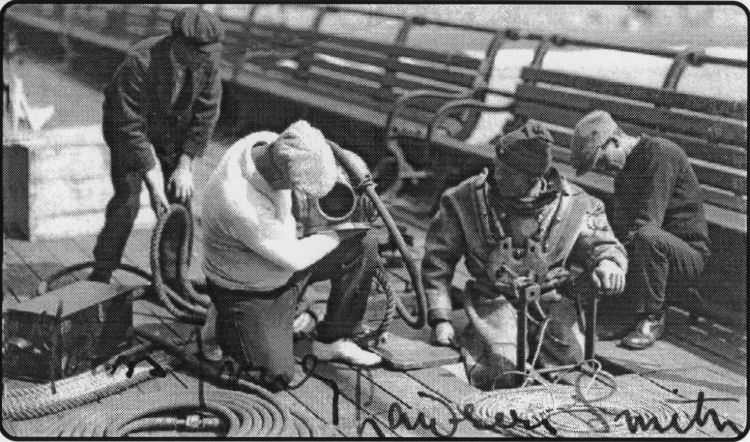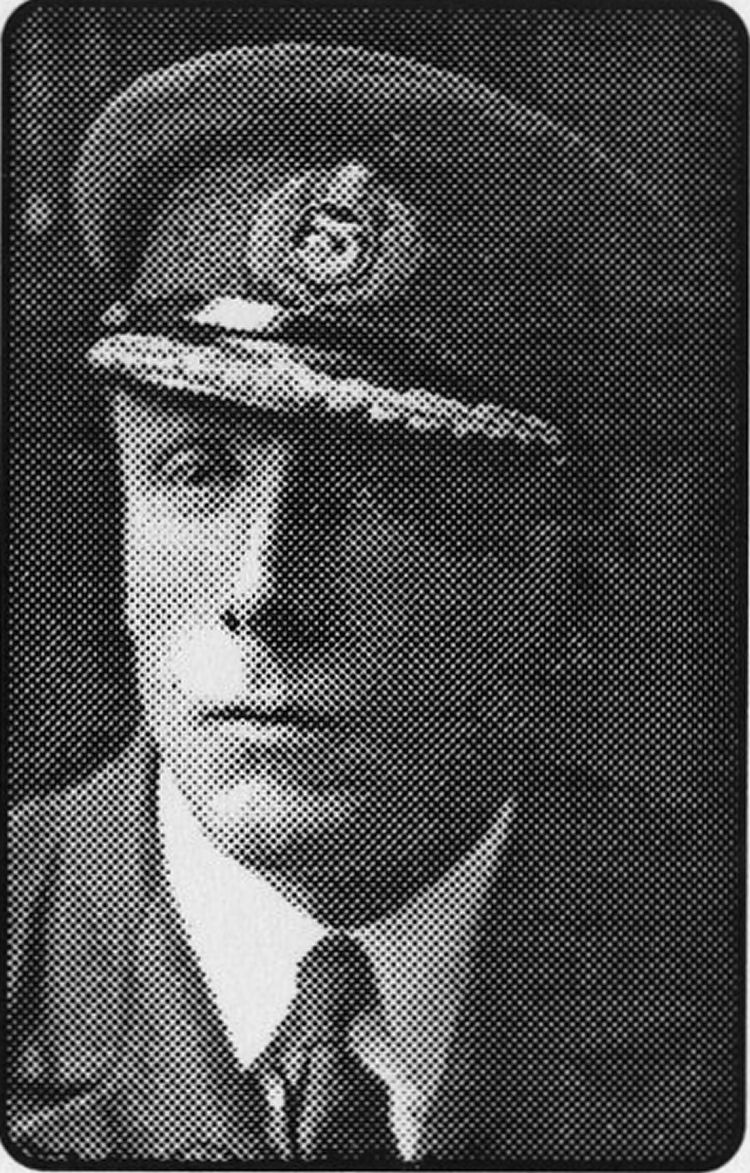
Published 21 March 2002
Bob note. Caption mentioned men in wrong order.

In too
THE photograph of diver Captain Lawson Smith who used to give demonstrations
on the old Victoria Pier, e-malled to us by Mike Dugdale of Sattwood, has
provoked a huge response from our readers.
Memories has already featured a portrait of the diver. Capt' Lawson Smith,
sent in by Philip Sidey. who says he seems to have been such a character' he
decided to try to find out more about him.
I looked up details of the intriguing court case against Lawson for
supposedly causing a disturbance by walking about wearing heavy brass diving
boots during a band concert in September 1937.
It seems he was wearing a diver's suit and clomping noisily along the Leas
promenade and along a path by the bandstand in his heavy boots - each
weighing 20lbs - as the band played.
He was said to have walked up and down, up and down, on the Leas and among a
seated audience.
Possibly nothing might have come of it, and some people might have seen the
amusing side of it.
But the trouble was. it annoyed the deputy mayor, Cllr R.L.T. Saunders, who
had been listening to the band and evidently lodged a complaint.
Smith, who gave his address at the Victoria Pier - from which he used to
give diving demonstrations - was taken to court for a breach of a byelaw,
the maximum penalty for which was £6.
In court Cllr Saunders said Smith could not avoid making a noise with his
heavy boots and it was of "considerable annoyance to people listening to the
music.” including himself.
Leslie Baker, the Leas attendant, said
he was on the Leas that evening, and saw the defendant in diving dress. His
heavy metal boots made a "terrible noise."
He added that when there was an interval in the programme Smith walked among
the audience. Cllr Saunders wasn't the only person to complain and he
emphasised that the irritating noise detracted from the music.
In his own defence Smith, pictured below, said the programme consisted
mainly of community singing and loudspeakers were in use to address the
crowd. These, he claimed, made a far greater noise than he could.
He denied being a nuisance and said he had every right to be on the Leas.
Evidence in his support was given by two visitors, Henry Seyman Topham and
his wife Maud, from Richmond Road, Clapham Common.
They said Smith's boots never disturbed them and Mr Topham said he heard no
complaints from people sitting around him. And Mr Topham was having no truck
with the prosecuting solicitor, who asked him if he was an admirer of Smith.
His reply was brief and to the point: "No," he said. "I like fair play!" But
the chairman of the magistrates said Smith had "unlawfully and wilfully
annoyed people" and he would be fined £1.
Smith had the last word: He said that in future "I will be a flannel foot,
and wrap flannel round the boots!"
Local author and historian Alan Taylor sent me a copy of the photograph.
above right, given to him by the late George Fenton, who taught him his
trade as a carpenter and joiner.
"When George left school he could not get a job to start with so he helped
IF YOU have any information about Capt Lawson Smith that might help Mr Sidey,
who is carrying out research into the life of the diver, with a view to
writing a book, the address to write to is:
Philip Sidey, The Cemetery Lodge, 46 Bell Road, Sittingbourne, Kent, ME 10
4EB. Or you can call him on 01795 472664 or his mobile number, 07808 185186.
Alternatively you can e-mail him at philsidey@aol.com
CAPTAIN Lawson Smith gets ready for another diving demonstration on the old
Victoria Pier. The picture was shown to me by Alan Taylor, stalwart of the
Folkestone & District Local History Society, who says it was given to him by
the late George Fenton who once assisted the diver.
Capt Smith for one season, in 1922, as pump boy."
Pictured on the postcard, of July 1922, from right to left are: Geo Fenton,
chief of diving operations (with white sweater, chief PO A Jackson RN
retired, Capt Smith and first assistant Alf Pace, said Alan.
George Fenton was awarded the George Medal for his part in rescuing an
injured man who had been blown up by landmines at the Royal Pavilion Hotel,
in October 1942, Alan told me.
Eric Hart, of Chart Road, told me another tale about Capt Lawson. Apparently
his children had a nanny or nursemaid who used to take them to Peter Pan's
Pool, in Radnor Park.
She had a 'crush' on a young man who was an assistant at the boating pool.
But one day. when she slipped into the cosy cabin where the staff row-
ing boat was stored, to see her young man, the youngest of the children took
a 'header' into the pool, which could have had dire consequences.
"I was there when the two 'canoodlers' were in the cabin, unaware of what
the two children were up to," says Eric. "The elder one, who was pushing the
other one around in the pushchair, got a bit too close to the water's edge
and in it went!
"Fortunately there was a gent passing by who grabbed the handle of the
otherwise submerged child and chair, and pulled them out.
"Just how the frantic nursemaid sorted this out remains a mystery," comments
Eric.
"But I wouldn't think that either of the children ever fancied following in
their father's footsteps after that!"

 |
Sir Edward Sassoon tells of children’s ward threat
«f Qf"\0 THE HERALD welcomed the news that.
prompted by General Sir Bevan Edwards, the Mayor, Earl Radnor, had
agreed to offer land to the Folkestone Cricket Club for a ground for 21
years on an agricultural rental. The site was north of Chertton Road,
opposite the cemetery. He also agreed to become president of the club. A
working deficit on the running of the town's Victoria Hospital could
bring about the closure of the children’s ward, warned Sir Edward
Sassoon, the hospital president, when he called for more public support
for the voluntarily funded service. At a public meeting of East Ward
ratepayers a large majority of those present voted In favour of a
resolution calling for a prompt start on a major East Cliff improvement
scheme which would add to the town's attractions, a new drainage scheme,
a Lower Sandgate Road Improvement, and the widening of Cherlton Road and
Radnor Park Road, without which the district's proposed tramway system
could not run on that route. There was a widespread belief, particularly
among those at the meeting, that Improvtng transport facilities boosted
trade.
|
Council welcomes ‘giff of Morehall playing ground
0t Q07 THERE was loud applause when councillors ■IA I heard that Lord
Radnor had offered to loase land for Morehall playing field at a nominal
rent, in fact the same terms as for Radnor Park - which was £5 a year -
after the Council had approached: him offering £200 an acre for the
site. The Earl's gesture was seen as a generous offer, in fact It was
practically a gift. The Town Council unanimously decided to appoint a
subcommittee to deal with unemployment. It was also agreed to send an
official Invitation to the Postal Workers Union which proposed to bring
about 800 delegates to Folkestone for Its annual conference. The Mayor,
Alderman R.G. Wood promised fellow guests at the annual dinner of the
Folkestone & District Master Builders Association that he would call a
conference in the Council chamber to try to find out why Folkestone was
not developing to the extent It should. He said he would be inviting
three each of the largest land owners, the leading builders, house
agents, solicitors who were involved In conveyancing, architects and
bankers to the conference. He wanted to see the town building not ISO
houses a year but 500, he said. He was confident they were on theverge
of a great step forward and Lord Radnor would help them.
|
Hopes of more jobs as US fiim lodes tor factory site
<1 Q eij HOPES of an American firm opening a drugs packaging factory In
the district and creating much needed Jobs for local people was revealed
by the mayor of Folkestone, Cllr JF Moncrieff, when he led a deputation
at the Employment Exchange to meet the deputy regional controller of the
London and SE Region of the Ministry of Labour and the Regional Offlcer
of the Board of Trade to impress on them the need for more jobs in the
area. There were 1,090 unemployed in the Folkestone, Hythe and Romney
Marsh area, the worst for many years and many people had to travel as
far as Ashford and even the Isle of Grain to get work. He also told how
the holiday trade had declined since before the war. how the town and
its homes and hotels had been hit by war damage, and, on top of that, a
proportion of wealthier residents had failed to return after the war.
The Herald began a story about one of Its most famous sons by printing
the words of a memorial plaque in the parish church: “AD 160S Nov 8th,
died in ye 50th yeare of her age, Joan, wife of Thomas Harvey, mother of
7 sones and 2 daughters..,,11 One of those sons of course, was William
Harvey whose life and achievements is marked by a striking statue on the
Leas;
|
#£/3///warning over lack of publicity for Arts Festival
H Q«7«7THE EDITOR was warning that the organis-JL«S f I ers of a
proposed major Festival of Arts in the district were being far to slow
in getting their act together over publicity. Brochures intended for
worldwide distribution had failed to appear, which risked putting the
whole venture In jeopardy. An Mangel” of the Bridge Street-Sidney Street
area In the hard days between two World Wars; that was how a Herald
correspondent from Norfolk described Mrs Sharman, the mother of
Folkestone’s eight singing Sharman brothers 25 years ago, A picture of
the St Saviour's Church choristers of the 20s and 30s, featured some
time ago in Memories. The Norfolk writer, Mrs Ivy Marsh, told how Mrs
Sharman was always on hand to help any family hit by sickness or
bereavement, particularly where children were concerned. Her
grandparents were licensees of the Alexandra Tavern, In Bridge Street.
Ancient Kite Manor, at Monks Horton, once iinked with Horton Priory, was
on themarket, and the Herald noted features included 1572 date marks :on
an oak beam over an open hearth and on a dormer sill, plus a heavily
studded door of between 1574-78. A Herald report that the intermittent
Nallbourne stream was flowing again through the Elham Valley prompted a
reader to quote 18th Century records stating the waters, sometimes
called called 'wlnter-bournea' had been known to flow twice a year. |
|



